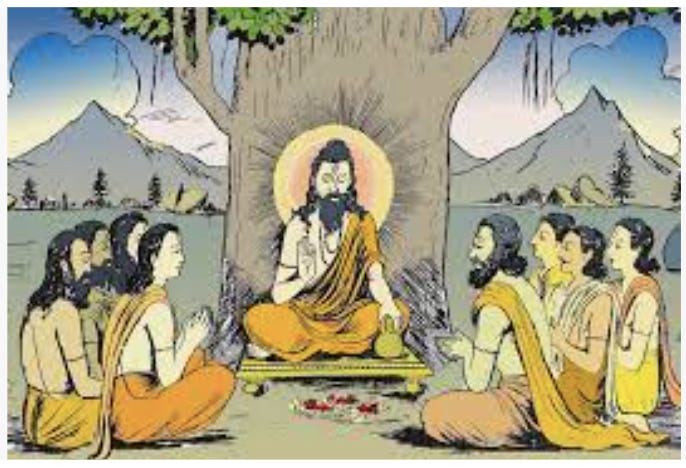Subjects that encompass knowledge that helps society and its members are considered disciplines in the best universities. However, those subjects that help people take care of their minds, themselves and empower their inner abilities are considered unscholarly. Self-development is considered unteachable and unprofessional. These tools are relegated to self-help groups, religious institutions, or sidelined as unacademic, as though self-help is indulgence.
If people develop themselves inside, so their minds can be strong from their core, why is that unscholarly? The best businesses provide exactly this training to help their core employees outperform. But these core employees are selected for loyalty, likeness, and ability to further the business' mission. They are otherwise unworthy. In some businesses, secrecy is renamed discretion; transparency is renamed need-to-know.
In the mainstream, understanding the mind has historically led to control of the mind and religious fanaticism. Witness any evangelism that does not teach its followers to think critically and independently.
So how then shall a person learn how to think, how to untie the knots in their minds and transform their obstacles and unhealthy reactions? Ayurveda is the science that teaches people how to heal! It provides its wisdom both at the household level with self-help kitchen remedies, and also at the professional level with detailed elegant surgical procedures and medicines for chronic diseases. Perhaps Ayurveda is suppressed because it interferes with the business of profiting from diseased people desperate for help.
Yet, despite all these power and control issues, there are hundreds of vaidyas who are silently sidestepping the nonsense of ineffective teaching and incompetent bridges of outdated pedagogy, by learning in the proven ways of ancient traditions. They have learned to return to the things that worked for 1000s of years rather than jumping first into the latest and often unproven techniques.
Those who understand the true principles of Ayurveda can test them out in the world, gain confidence, and then validate their awareness by helping patient after patient, marveling at the predictive, preventive and profound ways that shifting the doshas through the gunas and srotas work time after time. Women traditionally tested their awareness in their households, practicing meal after meal and by modifying lifestyle routines for the young and old. This living use of ayurveda 24/7 is the test of a good vaidya.
Vaidyas are difficult to find if you are using modern search strategies or credentials and awards to determine your decision. Go look in the kitchen and bathroom of an ayurvedic doctor/ayurvedic professional vs. a vaidya. The vast majority of their teachers are terrible role models. How then will a BAMS student become a vaidya?
The principles of Ayurveda are also unnecessarily difficult for medical students in ayurveda to learn because they have to unlearn the archaic knowledge in their outdated textbooks of basic mainstream biology, chemistry and medicine.
For example, if we believe that the gut is separated where our physiology text teaches, we will never understand the larger function of items that are omitted from the text, such as the understanding of food entering the body. New research in physiology shows that misconceptions due to poor or uninformed techniques have led to omissions, but even their research is not incorporated into medical education promptly. If we learn anatomy as the textbooks profess, we cannot see the structure-function relationships that underlie the body parts. The texts are not living. However, yoga movement scientists who use living bodies to learn, such as Leslie Kaminoff, have shown that fascial layers around the muscles connect the upper limbs through the trunk to the lower limbs. We accelerate our pace by using our arms and breath. His team has discovered principles of movements never found in medical texts.
Another example is of surgeons who have found capillaries linking the lungs to the stomach since the growth of the fetus, but this is not given importance in mainstream clinical medicine. Ayurveda however relates the fire and residue in the storage part of the upper stomach with the phlegm in the lungs. Clinically it is exactly what a doctor finds on reading anatomy research not found in textbooks, but only if her mind is open. This understanding tells us to clean out the stomach with digestive herbs such as ginger and cumin, and drink hot water, to clear out the lungs and reduce fevers.
To condition the mind to learn beyond the obstacles set by education specialists who are not actually wisemen is one of the tests of becoming a good vaidya. The true vaidya uses the ayurvedic medical texts to guide her exploration of the living vidya (true knowledge) and validate it through living patients. S/he interprets the texts differently than those who read the words and have no living references.
week133. published in The South Asian Times
Download the .pdf version of this column by clicking on the image.
Dr. Bhaswati Bhattacharya is a Fulbright Specialist 2018‐2023 in Public Health and Clinical Asst Professor of Medicine, Weill Cornell Medical College, New York. In addition to be a licensed physician, she received the blessings of the vidya-arambham ceremony for ayurveda personally selected by padmabhushan Raghavan Thirumulpad in 2000, and learned ayurveda through guru-shishya parampara, receiving the grantha and diksha of her teacher in 2003 and learning from his faculty at AVP for the past 20 years.









Thank you so much and I'm truly blessed and grateful to be reading these disruptive constructive articles so well bridging the gaps in western medicine and ancient Ayurveda!
During my grammar school years back in the ice age, class began with reciting the Pledge of Allegiance,a cacophonous rendition of the Star Spangled Banner, were seated and observed five minutes of silence for prayer, spirituality or gathering of thoughts.It was a very pleasing, cleansing reflective custom.
I don’t know how, when or why we began the devolution , shirking conscience, respect, our collective humanity, and ultimately, our independent, unique personhood. But it was by design.